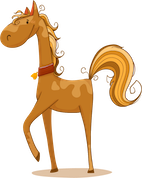
Level 1. Lesson 11. High & low sounds on a two-line staff
![]()
![]() Woodblock
Woodblock
Difficulty: ![]()
Prior learning: None
Prepare: so & mi Present: Practice: ta & ti-ti
![]()
Students will learn to perform a rhyme with coordinated movements, developing the feel of the beat, motor skills, and the ability to follow directions.
![]() Lyrics
Lyrics
Tap your head, tap your toe,
Turn in a circle, bend down low.
Tap your nose, tap your knees,
Hands on your shoulders, sit down, please!
 Questions
Questions
- Which movement was the easiest or most fun for you to do while saying the rhyme, and why?
- How did the actions help you remember the words in the rhyme?
- What was tricky about matching the movements to the rhyme?

- Arrange students in a circle.
- Begin by saying the rhyme to the class. Explain that the students will make different movements to match the words in the rhyme.
- Demonstrate each action slowly so the students can see what they will be doing.
- Say the first line and demonstrate tapping your head with one hand, then tapping your toe with the same hand. Have the students copy you.
- Say the second line while turning around in a circle, then bend down as low as possible. Have the students follow along with the movements.
- Say the third line, tapping your nose with one hand and then tapping your knees. Get the students to mimic your actions.
- Say the final line and place your hands on your shoulders. Then, sit down on the floor. Instruct the students to do the same.
- Once the students know the movements for each line, they should practice saying the rhyme together while doing the actions. Repeating it a few times will help them remember the sequence of movements.
 Success Criteria
Success Criteria
- I can say the rhyme while performing the correct actions.
- I can follow the sequence of movements in time with the rhyme.
- I can stay engaged and participate in the activity with my classmates.
![]() Students will identify high and low sounds in the song and learn how to represent them accurately on a two-line staff.
Students will identify high and low sounds in the song and learn how to represent them accurately on a two-line staff.
- Draw a single line on the board. Teach that this line helps us show that high sounds go above the line and low sounds go below the line.
- Sing the first four notes of "Goodnight" and invite a volunteer to come forward and draw circles (dots) for the first four sounds, replacing the “h” and “l.” Provide gentle guidance if needed.
- Repeat this with another volunteer to complete the song sequence.
- Draw a two-line staff, explaining we need to add another line below the low sounds so they don’t fall off! Now, we can see both high and low sounds more clearly.
- Sing the song again, pausing after each phrase.
- Rotate volunteers to come forward and place the high and low dots on the two-line staff.
- Encourage the class to provide feedback and guidance to the volunteers.
 Success Criteria
Success Criteria
- I can sing the song and identify high and low sounds.
- I can place high and low sounds as dots on one- and two-line staff.
- I can participate actively by contributing to the class activity on the staff.
 Questions
Questions
- Do you think using circles instead of letters to show high and low sounds is easier?
- Do you wonder if high and low sounds could have a special name?
- Why do you think we use circles to show sounds instead of something else, like pictures or shapes?
![]()
Students will develop beat awareness and coordination by singing, clapping, and participating in a movement-based circle game.
![]() Lyrics
Lyrics
Bell horses, Bell horses,
What's the time of day?
One o'clock, two o'clock,
Time to go and play!
- Gather students in a circle formation and explain that we will play a fun game called Bell Horses. One student will be the Bell Horse and move around the circle while we sing and clap to the beat.
- Review the song with the class to ensure everyone knows the melody and lyrics.
- Choose a student to be the first Bell Horse.
- Explain that the Bell Horse walks or sprints outside the circle as the class sings the song and claps the beat.
- When the song finishes, the Bell Horse freezes and picks the nearest student to become the next Bell Horse.
- Repeat the process with different students as time allows.
- Extension: Choose two students. One is the rider who carries jingle bells, and the other is the Bell Horse, who wears a scarf tied around its waist to act as reins.
- The rider gently "leads" the Bell Horse around the inside of the circle as the class sings and claps the beat.
- When the song ends, the pair chooses another two students to take their place.
- Repeat the process until several pairs have participated.
- Praise students for their teamwork, steady clapping, and singing.
 Success Criteria
Success Criteria
- I can sing the song and clap the beat in time with the class.
- I can move around the circle as the Bell Horse while the class sings.
- I can take turns and actively participate in the game.
 Questions
Questions
- How many different sounds can you hear in the song?
- Do you know what time it is now and when you go to play?
- What do you imagine a Bell horse is?

![]()
Students will learn to identify and play high and low notes on the xylophone while exploring pitch through listening and instrumental performance.
 Questions
Questions
- How did you know if the sound you played was high or low?
- What was the trickiest part about playing the instrument?
- Gather the class and explain that they will use a xylophone to explore high and low sounds.
- Distribute instruments and explain they will learn to play without singing.
- Play the first two measures of the song using C [so] and A [mi]
- Ask: “Which sound is high? Which sound is low?”
- Show students how to hold the mallets and strike the glockenspiel gently.
- Seat students in small groups (or a circle, depending on instrument availability).
- Call on one student at a time to play the first two measures of the song and sing using 'high' and 'low'.
- Depending on class ability, demonstrate the whole song and ask students to follow.
- Rotate students as time permits.
 Success Criteria
Success Criteria
- I can identify high and low sounds played on the xylophone.
- I can play high and low sounds accurately when prompted.
- I can listen carefully to distinguish between high and low sounds.
![]() Students listen to an imaginative story about a high and low note.
Students listen to an imaginative story about a high and low note.
The Adventures of High Sound and Low Sound
Once upon a time, in the magical land of Melody, there lived two best friends who sounded a lot alike but were just a little different. Their names were High Sound and Low Sound. High Sound was small, cheerful, and loved to skip through the air. Her sound was light and bright, like “Ding-ding-ding!” Low Sound's sound was deeper but still gentle, like “Dong-dong-dong!”
The two friends loved to play together. Every day, they bounced and rolled across the land of Melody, filling the air with music. “Ding-ding-ding!” went High Sound. “Dong-dong-dong!” followed Low Sound. Together, their music was smooth and happy, like two bells playing tag.
One morning, High Sound said, “Let’s go to Harmony Hill today! I heard the air is filled with the best sounds there.” Low Sound agreed. “That sounds perfect! I’ll follow you and make the nicest music together.”
High Sound skipped high above the grass as they started their journey, calling out her cheerful “Ding-ding-ding!” Low Sound stayed closer to the ground, rolling with his steady “Dong-dong-dong!”
When the birds in the trees heard them coming, they chirped along with their song. “Tweet-tweet!” sang the birds, sounding almost like little High Notes. “Coo-coo!” called the doves, adding their Low Notes.
The breeze was soft when they reached Harmony Hill, and the air felt magical. “Listen!” said High Sound. “Do you hear that?”
The wind was making music through the trees: “Ding-dong-ding-dong!” It sounded just like them!
High Sound giggled and said, “The wind plays like us! Let’s join in!” Together, they began to play. High Sound sang her “Ding-ding-ding!” and Low Sound followed with his “Dong-dong-dong!” The wind swirled around them, carrying their sounds far and wide.
Soon, all of Melody began to listen. The flowers swayed to the beat, the rabbits hopped in time, and the little squirrels tapped their tails. “What beautiful music!” they cheered.
Then, something funny happened. High Sound decided to try singing a little lower. “Dong-dong-dong!” she sang, mimicking Low Sound.
Low Sound smiled and tried singing a little higher. “Ding-ding-ding!” he sang, almost sounding like High Sound.
“Look at that!” laughed High Sound. “We can sound almost the same!”
“Yes,” said Low Sound, grinning. “But your voice is still higher, and mine is still lower.”
Together, they made their music: “Ding-dong-ding-dong!” It was smooth, even, and beautiful. The sound rolled gently down the hill and filled the air with joy.
By sunset, High Sound and Low Sound were tired but happy. They lay on Harmony Hill, listening to the wind play its song again.
“Ding-dong, ding-dong…”
High Sound smiled. “We’re a perfect pair.”
Low Sound nodded. “The best music happens when we work together.”
And so, from that day on, whenever someone heard a soft “Ding-dong-ding-dong” in the breeze, they knew that High Sound and Low Sound were out playing together, filling the world with their gentle, beautiful music.
The End.
![]()
Students will learn to identify, sing, and write rhythms accurately in a structured format, using visual aids to reinforce beat and rhythm concepts.
![]() Lyrics
Lyrics
ta, ta, ti-ti, ta
ti-ti, ti-ti, ti-ti, ta
- Distribute students' writing books[ i.e. My First Music Writing Book p.11] or the printed graphic.
- Lead the class in singing the song while clapping the rhythm, asking students to focus on matching their claps to the rhythm of the words.
- Guide students to sing the rhythm again, using time names (ta and ti-ti) instead of the lyrics.
- Ensure students maintain accuracy in rhythm and beat.
- Show students how to write the first time name [ta] under the umbrellas, dividing the song into two phrases.
- Guide students as they write the rhythm themselves, checking for accuracy.
- Review a few examples from the class, highlighting correct placement and rhythm.
 Success Criteria
Success Criteria
- I can sing the song while clapping the rhythm.
- I can sing the rhythm using time names (ta and ti-ti).
- I can write the rhythm correctly in two phrases under the visual representation of the beat.
 Questions
Questions
- How many beats are in the song? [8]
- What do the umbrellas represent? [the beat]
- Was singing the rhythm with the time names or the lyrics easier?
![]() ASSESSMENT QUESTIONS
ASSESSMENT QUESTIONS
- The student can perform a rhyme with coordinated movements.
- The student can identify high and low sounds.
- The student can write the rhythm correctly in two phrases under the visual representation of the beat.

Suggested lessons
Y1. Beat II

Y1. Beat III

Y1. Beat IV

